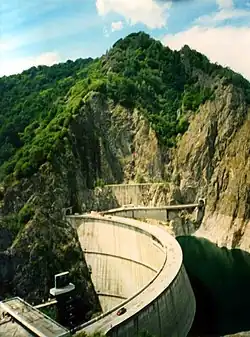In accordance with EU directives and climate control ambitions, additional effort and money was put into improving renewable energy sources. The target of 24% renewable energy was reached in 2020.[1]
Since the 2022 Russian Invasion of Ukraine the need to strengthen and diversify sources of electricity was given a boost. A target of 30.7% renewable energy generation has been set, to be achieved by 2030, however planning is being undertaken to increase this to 34%.[1]
Consumption in 2022 was 51,708.9 million kWh, 7.2% less than 2021. 7,325.1 million kWh were exported in 2022.[1]
Electricity source analysis
According to the data displayed by Electrica Furnizare SA in August 2020 (source www.electricafurnizare.ro), the structure of electricity production of Romania in 2019 was provided by:
|
1. High-carbon energy sources: 38.85%, as follows
|
2. Low-carbon sources: 61.13%, as follows
|
The EU Just Transition Fund is targeting coal-reliant countries and Romania is hoping to receive €4.4 billion of the €17.5 billion fund to support the transition to clean energy in 2024-30, in 2022 coal still represented 18.38% of electrical production.[1]
Hydroelectric power

Hidroelectrica run Hydroelectric power plants in Romania.[2]
Romania has an estimated total usable hydropower of 36,000 GWh per year.[3]
Wind power
Installed capacity of 3,028 MW as of the end of 2016,[4] up from the 14 MW installed capacity in 2009.
By 2021 this had risen to 17% of total installed power generation capacity and 13% of total power generation.[5]
Solar power
A small source in Romania, 1,772.2 million kWh was generated, representing just 1.76% of 2022 electrical production.[1]
It is intended to increase solar from 1.3GW to 5GW by 2030.[1]
Nuclear power
Romania placed a heavy emphasis on nuclear power generation. The country's first nuclear power plant, the Cernavodă Number One located near Cernavodă, opened in 1993. Two reactors were operational in 2007 when atomic power generation was an estimated 21,158 million kilowatts, or 23.1 percent of total electric power.
To cover the increasing energy needs of its population and ensure the continued raising of its living standard, Romania plans several nuclear power plants. Nuclear power proposals were presented as early as in the 1990s, but plans were repeatedly canceled even after bids were made by interested manufacturers because of high costs and safety concerns.
Besides the nuclear power plant in Cernavodă, which consists of two nuclear reactors, the Government has recently announced that it plans to build another nuclear power plant which would most likely be located near one of the major rivers in Transylvania. The new nuclear power plant would consist of two nuclear reactors and would have a total output of 1,413 MW and was under construction in 2022.[6]
Romania has always chosen CANDU nuclear reactors because they use natural unenriched uranium which is cheap and available locally and because they can be refueled online.
References
- 1 2 3 4 5 6 "The Renewable Energy Law Review: Romania". 20 July 2023.
- ↑ "Este oficial. Hidroelectrica anunță intenția de listare pe Bursa de Valori București. Fondul Proprietatea vrea să strângă peste un miliard de euro în oferta publică inițială de acțiuni (Reuters)". 6 June 2023.
- ↑ Nine O'Clock, issue 4013, page 7
- ↑ http://www.ewea.org/fileadmin/files/library/publications/statistics/EWEA-Annual-Statistics-2015.pdf
- ↑ "Wind power capacity in Romania and major projects". 20 June 2023.
- ↑ "Romania - Country Commercial Guide". 27 July 2022.